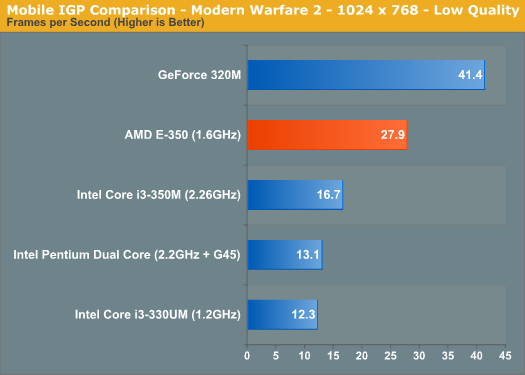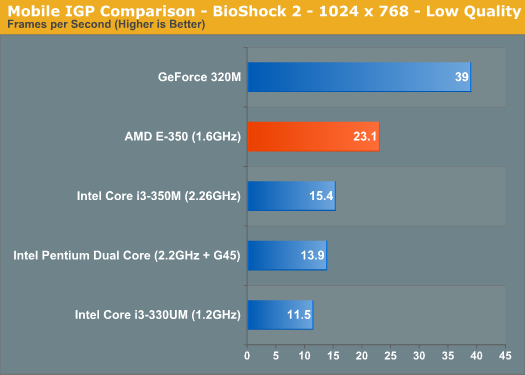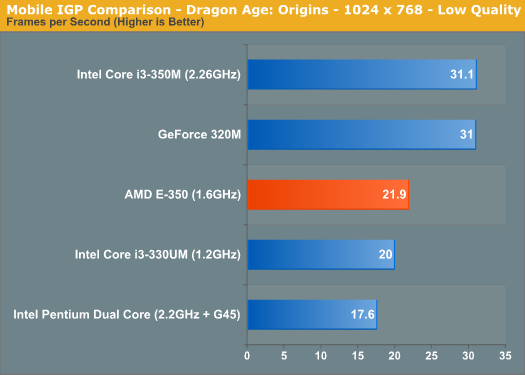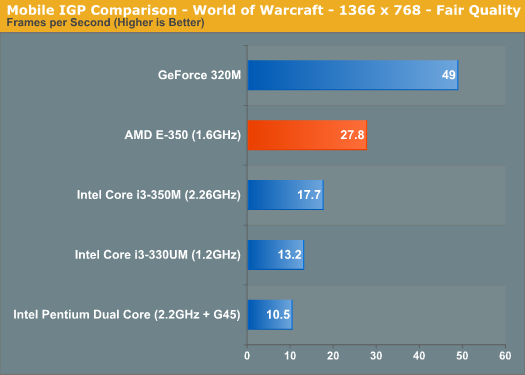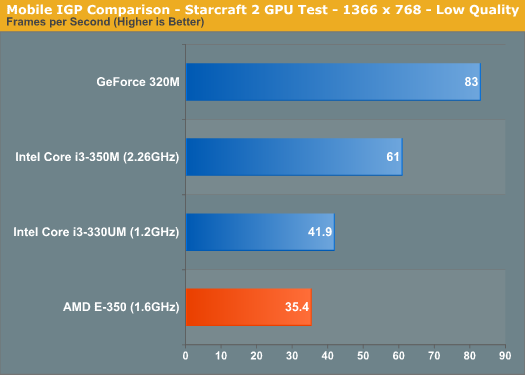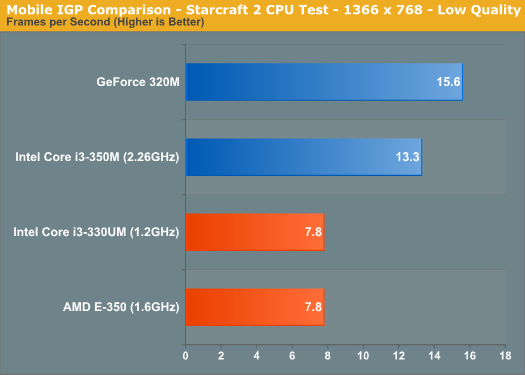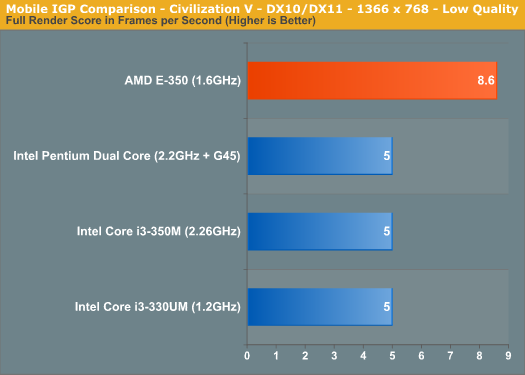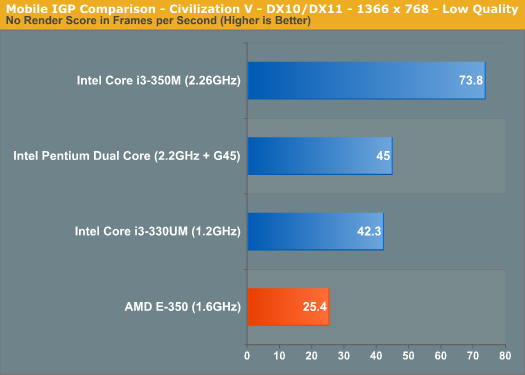
|
TopNax |
|
Home†††††† Previous††††††† AMD page†††††††† Intel page†††††††† Next |
Mobile IGP ComparisonI narrowed down the platforms for our mobile IGP comparison. I simulated a Core i3 350M by taking an i3-530, underclocking it (I couldn't do anything about the 4MB vs. 3MB L3 cache) and capping its GPU frequency at 667MHz. This is the best case scenario for the i3-350M, and as you'll see below, it doesn't really matter. I also paired a 2.2GHz Pentium Dual-Core with a G45 motherboard, agian simulating the cheaper mobile Pentium platform. Finally I installed Windows 7 on the 1.6GHz Core 2 Duo based 11-inch MacBook Air with its GeForce 320M to give you an idea of the upper bound for mobile performance with what might as well be a low end discrete GPU. Updated: I've added performance results from a simulated Core i3-330UM, the E-350's competition in ultra portables. We'll start with Modern Warfare 2:
The E-350 puts the i3-350M, i3-330UM and Pentium DC to shame, delivering 67% better performance. The frame rate is just shy of being totally smooth however. I found that in most modern games 1024 x 768 would result in frame rates just under 30 fps.
BioShock 2 showed a similar performance advantage. Again we're not able to break 30 fps but the performance advantage is huge compared to the Intel platforms with integrated graphics.
Dragon Age: Origins is mostly CPU bound at low quality settings and thus there's no real advantage to the E-350's Radeon HD 6310 GPU. It's faster than the Pentium/G45 platform, but significantly slower than the i3-350M. I expect most games however to be GPU bound at these settings across the board.
World of Warcraft continued the trend. The E-350 ended up 57% faster than the i3-350M, although still fell short of a discrete GPU. Of course I wondered how well Brazos would play Starcraft 2:
The GPU handles SC2 just fine, however the game is very CPU dependent and thus you see a pretty big advantage from the mainstream i3 system. The comparison is a lot closer when we look at the i3-330UM. The E-350 won't be able to play SC2 as well as a $500 mainstream notebook, but it'll be comparable to an ultraportable running ULV Arrandale. We don't have numbers for the G45 platform here because the system wouldn't run our benchmark (our tests use an older version of SC2 which apparently had issues with the G45 drivers). Our SC2 CPU test gives you an idea of the lower end of performance in large multiplayer battles:
The E-350 offers only 58% of the performance of the i3-350M system. The Bobcat cores do hold the platform back from time to time. Again, compared to the i3-330UM there's no performance difference at all. Just for kicks I also ran the Civilization V benchmark, which gave us two datapoints: GPU performance and no-render/CPU performance.
The benchmark doesn't score well on either platform, although AMD does hold a 72% performance advantage over the i3 and G45 platforms. The CPU test puts the E-350 at about 55% of the speed of the Pentium dual core platform.
Civ V is one area where the Arrandale CPU advantage wins out over GPU performance. Overall, the E-350 has no problems outperforming any of the current Intel integrated graphics offerings in 3D games. In CPU bound titles the E-350 loses out to the mainstream i3, but is competitive with ultra low voltage i3s. Just as with Atom, you'll have to sacrifice performance vs. a mainstream notebook, but compared to low voltage Arrandale the E-350 can hold its own. |
Final WordsThe Brazos platform really poses the question of what is fast enough from a CPU standpoint. Netbook makers often argued that Atom was fast enough, and honestly they'd be right if Atom wasn't paired with such a heavyweight OS. Running Windows 7, Atom just wasn't fast enough but many made the sacrifice in order to get the form factor and battery life benefits that went along with the platform. The E-350 offers an alternative. You get faster than Atom CPU performance (particularly in single threaded tasks) and a fairly potent GPU. The only issue is that the E-350 doesn't compete against Atom. Most of the time you'll find it up against Pentium or low end Core i3 notebooks.
From a CPU performance standpoint, the E-350 can't compete with either of those CPUs clock for clock. Where AMD has the advantage is in power consumption and GPU performance. This is effectively AMD's answer to Intel's CULV platform, but with better graphics performance. This is a huge statement from AMD, echoing what Apple has been saying for the past year: while CPU performance matters, GPU performance must scale at least as quickly, if not more to make up for lost time. The only thing we're really lacking are the killer apps (outside of 3D gaming and HD video) to support this mentality today. The Radeon HD 6310 in the E-350 does very well, despite the memory bandwidth limitations. Its easily faster than Intel's HD Graphics, although some games (e.g. Starcraft 2) are still held back by the performance of AMD's Bobcat cores. Despite being a significant step forward for integrated graphics at this price point, I would be lying if I said I didn't wish it were faster. Ideally I would like to see > 30 fps performance across the board from the E-350. There's also the GPU compute argument that AMD makes for Fusion, however the GPU compute tests I tried to run on Brazos didn't exactly work. Cyberlink Media Espresso would not use the GPU for encoding and the Civilization V compute shader test wouldn't run either. Both I suspect will be worked out by the time the platform actually ships. What matters the most with Brazos is what the OEMs do with it. We'll of course get mini-ITX boards to turn into HTPCs, but on the mobile side Brazos needs to be paired with a sleek/well built chassis, good display, fast storage and a large battery to truly be attractive. I am also concerned about the performance of the Ontario based APUs. In many areas the E-350 isn't that much quicker than a dual-core Atom, which makes me wonder how the C-30 and C-50 would do. Brazos ultimately has the same problem Atom had at its introduction. Compared to similarly priced notebooks based around 2.2GHz Pentium dual-core CPUs or Core i3s, the CPU just isnít competitive. Unlike Atom however, in GPU bound scenarios the E-350 is actually faster than those two. The only issue, as I mentioned above, is that currently the majority of mainstream applications that are GPU bound are 3D games. Like Atom however, the Brazos platform is also destined for ultra thin formfactors - places a low end Core i3 canít go. Itís in that comparison that AMD is most successful.
Compared to a Core i3-330UM, Brazos offers much better GPU performance and itís even competitive in CPU dependent games like Starcraft 2. The i3-330UM is still faster CPU bound scenarios though, reinforcing the CPU speed for GPU performance tradeoff that youíre faced with when considering these two.
The E-350 delivers 50 - 60% of the multithreaded CPU performance of the Core i3-330UM, and nearly 70% of the single threaded performance. Itís a noticeable gap, but AMD attempts to make up for it by delivering up to twice the GPU performance in games.
Then thereís the issue of die size. For years AMD has had to give sell you a larger die at a lower price than Intel in order to remain competitive. The Brazos platform changes that. At 75mm^2, the Zacate die is smaller than just the CPU portion of a Core i3 and itís less than 40% of the total die area when you include Intelís HD Graphics. While more CPU performance would be nice to have, this is a good start.
AMD is committed to revving the Brazos platform yearly. Weíll obviously see updated graphics next year but Iím hoping for updates to the CPU cores as well. The biggest mistake Intel made with Atom was to be too conservative with its roadmap. AMD has a history of not making the same mistakes as Intel, so hopefully the Brazos roadmap looks good. Now we wait for the notebooks |
|
Home†††††† Previous††††††† AMD page†††††††† Intel page†††††††† Next |
